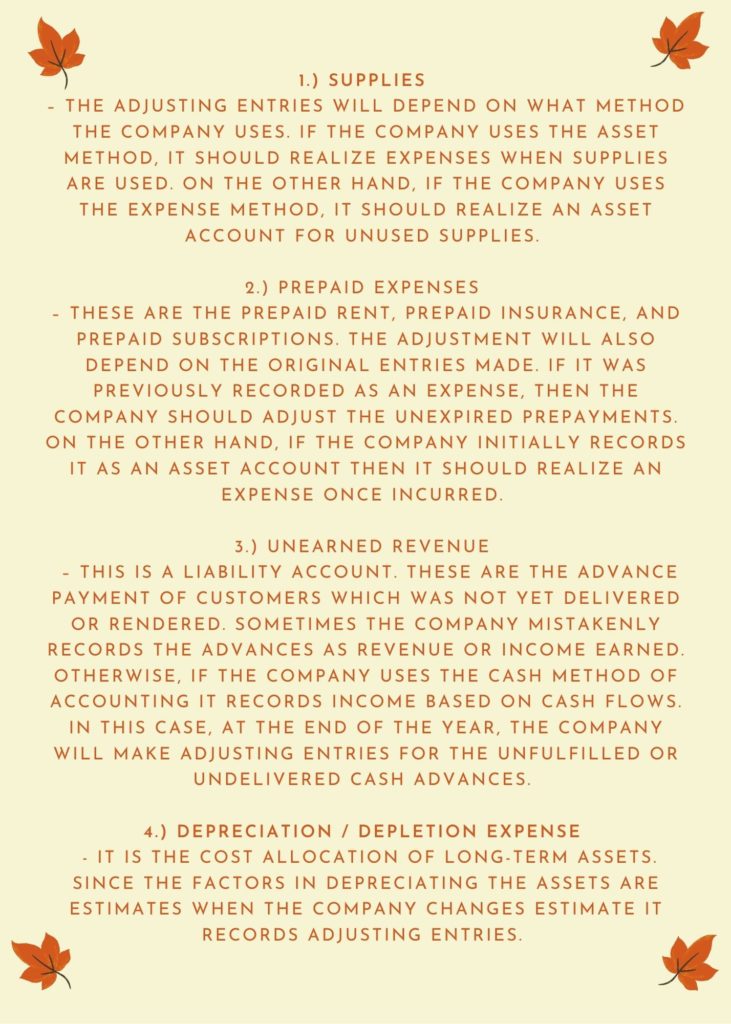Adjusting Entries is a way to adjust or correct the balances of financial statements. For instance, the company uses the expense method of accounting for stationery and supplies accounts. Moreover, rentals and insurance. Normally, if the company uses the expense method, it records all the purchases of stationery and supplies as an expense. As well as payment of two-year rent and insurances it records the whole payment as expense regardless of how long the contract takes place. Recording these transactions as an outright expense does not follow the matching principle. The matching principle talks about matching the expenses with its related revenue. Although some businesses use this method, at the end of the year they adjust the balances for accurate data.
In this case, the purchases of stationery and supplies were recorded outright expense. In reality, not all of this stationery and supplies is use at the end of the year. There will be left unused. This is the part where adjusting entries are used. Before closing the temporary accounts (income and expenses) of books, the company will adjust. For example, at the end of the year, the company realize that some stationery and supplies are still unused. Since the company uses the expense method, it was recorded previously as an expense account. Therefore, at the end of the year, the company will make adjusting entries to realize the unused supplies.
Why do we need to do adjusting entries?
The reason we do adjusting entries is to make the financials accurate and realistic. For instance, the long-term asset depreciation (cost allocation) expense. The factors we use in depreciating the assets are useful life, the method of depreciation, and the salvage value. These factors are merely estimates. When the company realizes that the useful life estimates made are unrealistic in the succeeding years, the company will adjust. Making adjustments is bringing the unrealistic figures to a realistic one. This is to help financial end-users and the decision-maker, decide correctly. Overstated or understated balances affect the decision-making of the financial end-users.
Moreover, the company itself. Assuming the estimated useful life of the assets was realize overstated in the succeeding years. And the company didn’t make any adjustments. As a result, understatement of depreciation expense. The understatement of expense makes the income overstated. Overstatement of income means over remittance of taxes. Not only taxes but also the decision-making of the management for instance in giving bonuses. In addition, wrong cost allocation (depreciation) of an asset. The company is expecting the assets to perform more years but in reality, it can only perform a year or less. Adjusting entries is very important.
Accounts that need adjusting entries
1.) Supplies
The adjusting entries will depend on what method the company uses. The company should realize expenses given that it uses asset method. On the other hand, if the company uses the expense method, it should realize an asset account for unused supplies.
2.) Prepaid Expenses
These are the prepaid rent, prepaid insurance, and prepaid subscriptions. The adjustment will also depend on the original entries made. The company adjust the unexpired prepayments if previously recorded as an expense. On the other hand, if the company initially records it as an asset account then it should realize an expense once incurred.
3.) Unearned Revenue
This is a liability account. Unearned income is the advance payment of customers which not yet delivered or rendered. Sometimes the company mistakenly records the advances as revenue or income earned. Otherwise, if the company uses the cash method of accounting it records income based on cash flows. In this case, at the end of the year, the company will make adjusting entries for the unfulfilled or undelivered cash advances.
4.) Depreciation / Depletion Expense
It is the cost allocation of long-term assets. Since the factors in depreciating the assets are estimates when the company changes estimate it records adjusting entries.
Note: The above accounts are examples that need adjustments, but are not limited to them. Errors made also need adjustments. Errors can happen anytime. Wrong posting of accounts, overlooked amounts, double posting, and no posting are some common errors . These errors require adjusting entries to correct the balances of financial statements.

Conclusion (adjusting entries):
We use adjusting entries to correct the balances, the estimates, and the errors made. Adjusting entries also used to bring the wrong balance of financial statements to accurate data. Supplies, prepayments, unearned income, depreciation are accounts that usually have the adjusting entries. Adjusting entries are important because not doing so could affect the financial end-users and the company itself.
Related Blogs: Depreciation and Depletion
Learn more about Journal Entries and Adjusting Journal Entry